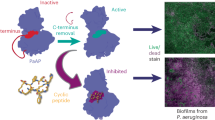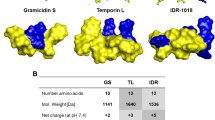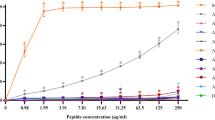Abstract
Cysteine proteinases are important not only in the intracellular catabolism of peptides and proteins1 and in the processing of prohormones and proenzymes2,3, but also in the penetration of normal human tissue by malignant cells4 and possibly microorganisms5, including viruses. Cystatin C is a human cysteine proteinase inhibitor present in extracellular fluids6. We have synthesized peptide derivatives mimicking the proposed proteinase-binding centre of cystatin C7 and find that they irreversibly inhibit cysteine proteinases. Several bacteria produce proteinases, so we tested a tripeptide derivative (Z-LVG-CHN2) for in vitro anti-bacterial activity against a large number of bacterial strains belonging to thirteen different species. It was found to inhibit specifically the growth of all strains of group A streptococci. The susceptibility of these human pathogens to the peptide was compared with that to well-established anti-streptococcal antibiotics such as tetracy-cline and bacitracin. Moreover, the peptide was active in vivo against group A streptococci: mice injected with lethal doses of these bacteria were cured by a single injection of Z-LVG-CHN2. The cysteine proteinase produced by group A streptococci was isolated and found to be inhibited by Z-LVG-CHN2; moreover, excess proteinase relieved the growth inhibition caused by the peptide derivative, suggesting that the antibacterial activity of Z-LVG-CHN2 is due to inhibition of this cysteine proteinase. This strategy of blocking proteinases with peptide derivatives that mimic naturally occurring inhibitors could be useful in the construction of new agents against other microorganisms, including viruses.
This is a preview of subscription content, access via your institution
Access options
Subscribe to this journal
Receive 51 print issues and online access
$199.00 per year
only $3.90 per issue
Buy this article
- Purchase on Springer Link
- Instant access to full article PDF
Prices may be subject to local taxes which are calculated during checkout
Similar content being viewed by others
References
Barrett, A. J. & Kirschke, H. Meth. Enzym. 80, 535–561 (1981).
Marks, N., Berg, M. J. & Benuck, M. Archs Biochem. Biophys. 249, 489–499 (1986).
Taugner, R., Buhrle, C. P., Nobiling, R. & Kirschke, H. Histochemistry 88, 103–108 (1985).
Sloane, B. F. & Honn, K. V. Cancer Metastasis Rev. 3, 249–263 (1984).
Barrett, A. J., Davies, M. E. & Grubb, A. Biochem. biophys. Res. Commun. 120, 631–636 (1984).
Abrahamson, M., Salvesen, G., Barrett, A. J. & Grubb, A. J. biol. Chem. 261, 11282–11289 (1986).
Abrahamson, M. et al. J. biol. Chem. 262, 9688–9694 (1987).
Liu, T.-Y. & Elliott, S. D. The Enzymes 3, 609–639 (Academic, New York, 1971).
Green, G. D. J. & Shaw, E. J. biol. Chem. 256, 1923–1928 (1981).
Barrett, A. J. et al. Biochem. J. 201, 189–198 (1982).
Higgins, C. F. Nature 327, 655–656 (1987).
Author information
Authors and Affiliations
Rights and permissions
About this article
Cite this article
Björck, L., Åkesson, P., Bohus, M. et al. Bacterial growth blocked by a synthetic peptide based on the structure of a human proteinase inhibitor. Nature 337, 385–386 (1989). https://doi.org/10.1038/337385a0
Received:
Accepted:
Issue Date:
DOI: https://doi.org/10.1038/337385a0
This article is cited by
-
Cystatin C is a disease‐associated protein subject to multiple regulation
Immunology & Cell Biology (2015)
-
Bacterial proteases: targets for diagnostics and therapy
European Journal of Clinical Microbiology & Infectious Diseases (2014)
-
Proteomic analysis of seminal fluid from men exhibiting oxidative stress
Reproductive Biology and Endocrinology (2013)
-
Hydrogen Peroxide Induces Lysosomal Protease Alterations in PC12 Cells
Neurochemical Research (2007)
-
Identification, cloning and functional characterization of novel sperm associated antigen 11 (SPAG11) isoforms in the rat
Reproductive Biology and Endocrinology (2006)
Comments
By submitting a comment you agree to abide by our Terms and Community Guidelines. If you find something abusive or that does not comply with our terms or guidelines please flag it as inappropriate.



